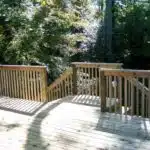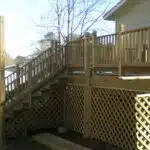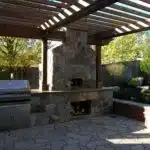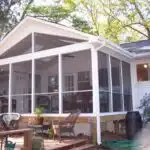Building a floating deck is a cost-effective and versatile way to add an outdoor living space to your home. It provides the perfect setting for relaxing, entertaining guests, or enjoying a meal with your family. A floating deck is also an ideal option if you have uneven or sloping ground in your backyard that makes it difficult to build a traditional deck.
As a professional deck builder, I understand the importance of creating a durable and sturdy structure that can withstand the elements and provide long-lasting enjoyment. In this article, I will share my expertise on how to build a floating deck that is both functional and aesthetically pleasing. Whether you’re a DIY enthusiast or looking to hire a contractor, this guide will provide you with all the essential steps and tips needed to create the perfect floating deck for your home.
Choosing The Right Location For Your Floating Deck
When it comes to building a floating deck, the first thing you need to consider is the right location. The location you choose will have an impact on the overall look and feel of your deck, as well as its safety and longevity. Therefore, it’s important to take your time when selecting a spot for your new deck.
Environmental considerations are paramount when choosing a location for your floating deck. You need to think about how the environment will affect your deck over time. For example, if you live in an area that experiences heavy rainfall or high winds, you may want to avoid areas that are prone to flooding or storm damage. Similarly, if you live in a region with harsh sunlight or extreme temperatures, you may want to consider shading options for your deck.
Maximizing views is another key factor in choosing the right location for your floating deck. Whether you want to enjoy scenic views of nature or simply enhance the aesthetic appeal of your backyard, the location should be chosen carefully. Consider where the sun sets and rises, whether there are any trees or other obstructions that could block views from certain angles, and what kind of scenery will be visible from each potential spot. With these factors in mind, you’ll be able to choose a location that maximizes both safety and beauty for your floating deck project.
When it comes to building a floating deck, choosing the right location is crucial. Environmental factors such as climate and terrain must be considered along with maximizing views. Once you’ve selected the perfect spot for your new deck, it’s time to obtain any necessary permits and permissions before starting construction.
Obtaining Necessary Permits And Permissions
After determining the right location for your floating deck, it’s time to dive into obtaining the necessary permits and permissions. It is important to note that building codes vary from one city to another, so you need to check with your local government office for specific regulations that apply in your area. The permit process can be overwhelming, but it helps ensure that the construction of your deck complies with legal requirements.
Before starting any construction work, you must obtain a building permit. The local government office will require you to submit plans and drawings of the proposed structure as well as other necessary documents such as property surveys and engineering reports. The building inspector will review these documents before issuing a permit. It is essential to follow all legal requirements during this process; otherwise, you may face hefty fines or even demolition of your deck.
The legal requirements for getting a permit may seem daunting, but they help protect both you and the community. Once you have obtained the necessary permits and permissions, you can proceed with constructing your floating deck. In the next section, we will discuss how to decide on the size and shape of your deck based on your needs and available space.
Deciding On The Size And Shape Of Your Deck
Deck design is the first and foremost step in building a floating deck. The size and shape of your deck should be determined by various factors such as space availability, intended usage, and budget. It’s important to carefully consider these factors before proceeding with the design to ensure that you end up with a deck that meets your needs.
When designing your deck, it’s also important to consider any specific features or elements that you want to incorporate into the design. For example, if you plan on using your deck for entertaining guests, you may want to include built-in seating or a bar area. Additionally, if you have any landscaping or other outdoor features that you want to highlight, you may want to design your deck around these elements.
Material selection is another key aspect of designing your floating deck. There are many different materials available for decking, including wood, composite materials, and PVC. Each material has its own pros and cons in terms of durability, maintenance requirements, and cost. When selecting materials for your deck, it’s important to consider these factors carefully and choose the option that best fits your needs and budget.
As you can see, designing a floating deck requires careful consideration of several different factors. By taking the time to think through these details thoroughly before beginning construction, you can ensure that your finished product will meet all of your needs and expectations. In the next section we will discuss determining the materials needed for your project so that we can move forward with construction planning without delay.
Determining The Materials Needed For Your Project
Before starting any deck building project, it is essential to determine the materials required. Decking options may vary from natural wood to composite materials that are versatile and long-lasting. Natural wood decks require regular maintenance, such as staining or sealing, whereas composite decking requires little maintenance but comes at a higher cost. Therefore, it is crucial to weigh the pros and cons of each decking option before deciding on which one to use.
Once you have decided on the type of decking material you want, the next step is to estimate the costs involved. The cost estimation will depend on various factors such as size, materials used, labor costs, and other necessary accessories like fasteners and hardware. To determine an accurate cost estimate, it is advisable to consult with a professional deck builder who can provide insights on pricing based on your specific project requirements.
In conclusion, determining the materials needed for your floating deck project is a crucial step in ensuring its success. Choosing the right decking material based on its pros and cons and estimating costs accurately can help you stay within budget while achieving your desired outcome. The next step is preparing the ground for your deck by following specific guidelines that ensure stability and durability for years to come.
Preparing The Ground For Your Deck
As a professional deck builder, I have always emphasized the importance of landscape preparation before starting the actual construction. Preparing the ground where you will install your floating deck is crucial since it ensures the stability and longevity of your project. It also helps in preventing any possible damage to your property.
Landscape preparation starts with clearing the area where you plan to build your deck. Remove any existing plants, rocks, or debris that may hinder the leveling process. Once you have cleared the area, level it out by removing high spots and filling in low spots using a shovel or a rake. Make sure to take time during this step since it will affect how stable your deck will be.
Ground leveling is an essential part of landscape preparation that should not be overlooked. Ensure that the ground is well-compacted and free from any debris that may cause instability in your deck’s foundation. Once you have leveled out the ground, you are now ready to proceed with building the frame for your deck.
Building The Frame For Your Deck
The frame is the foundation of your floating deck, and it’s crucial to get it right. Start by measuring and marking out the perimeter of your deck using stakes and string. Then, dig holes at each corner to a depth of around 12 inches. Next, insert concrete footings into each hole and let them set for at least 24 hours before proceeding.
Once your footings are ready, you can begin building your deck frame. Use pressure-treated lumber for the frame as it can withstand moisture and last longer than other types of wood. Cut your pieces to size and secure them together with galvanized screws or nails. Reinforce the frame for heavy use by adding additional supports in strategic places such as under stair treads or where railings will be installed.
Decking material options should also be considered when building the frame for your floating deck. If you plan on using composite decking, make sure to leave a gap between boards as they tend to expand in warm weather. On the other hand, if you decide on wood decking, keep in mind that some types may require more maintenance than others. Regardless of which option you choose, ensure that the decking material is compatible with your chosen frame design and construction method.
Transition: Now that your deck frame is in place and reinforced for heavy use, it’s time to move on to installing the decking boards.
Installing The Decking Boards
Once the frame and joists have been securely installed, it’s time to start laying down the decking boards. One of the most important considerations here is spacing: each board should be positioned with a small gap between them to allow for expansion and contraction due to temperature changes. This gap should be about 1/8 inch, or roughly the width of a standard carpenter’s pencil.
When it comes to patterns, there are a few options available depending on your personal preferences. The most common pattern is a simple parallel arrangement, with each board running perpendicular to the joists below. However, you can also experiment with diagonal patterns or even herringbone designs for a more eye-catching finish. Just keep in mind that more complicated patterns may require additional cutting or shaping of individual boards.
Overall, the key to installing decking boards is taking your time and working methodically. Make sure each board is level and flush with its neighbors before moving on to the next one, and take care not to damage any of your existing work in the process. With patience and attention to detail, you’ll have a beautiful floating deck in no time at all.
As we near completion of our floating deck project, it’s important not to forget about safety considerations like adding railings and balusters. Not only do these features prevent falls and injuries, but they can also add an extra layer of visual appeal to your finished product. In the next section, we’ll walk through some simple steps for incorporating these elements into your design seamlessly.
Adding Railings And Balusters For Safety
With the decking boards securely in place, it’s time to focus on adding railings and balusters to your floating deck. This is a crucial step in ensuring the safety of anyone who will be spending time on your deck. Not only do they add an extra layer of protection against falls, but they also provide a decorative element that can enhance the overall look of your outdoor space.
When it comes to choosing baluster design options for a floating deck, there are plenty to choose from. Some popular choices include traditional wooden spindles, sleek metal rods or cables, or even tempered glass panels for an unobstructed view. Keep in mind that while design is important, safety should always be the top priority. Be sure to follow local regulations when it comes to spacing between balusters and railing height.
Speaking of safety regulations, it’s important to note that railings on a floating deck must meet certain requirements. The International Residential Code (IRC) specifies that decks over 30 inches off the ground must have railings at least 36 inches tall. Additionally, any openings between balusters should not exceed 4 inches in width to prevent children or pets from getting stuck or falling through. Following these guidelines will ensure that your deck is both beautiful and safe for everyone who uses it.
As you finish up the installation of your railings and balusters, you may want to consider building stairs or ramps for access if your deck is particularly high off the ground. This can make it easier and safer for guests with mobility issues or those carrying heavy items like grills or furniture onto the deck. Stay tuned for our next section where we’ll dive into the details of building stairs or ramps for access without compromising safety or aesthetics.
Building Stairs Or Ramps For Access
Stair design and ramp construction are essential components of building a floating deck. The design of your stairs or ramp should be based on the height of your deck and the accessibility needs of your family and guests. When planning your stair design, you should consider the rise and run measurements to ensure that each step is comfortable to climb.
Ramp construction requires careful consideration of the slope gradient to provide easy access for wheelchairs, strollers, and other mobility aids. You should also use non-slip materials on the surface of ramps to prevent accidents. It is important to comply with local building codes for both stairs and ramps when constructing them as they will ensure safety for everyone who uses them.
To help you understand stair design and ramp construction better, below is a table summarizing the key differences between these two access points:
| Stairs | Ramps |
|---|---|
| Vertical steps | Sloping surface |
| Suitable for able-bodied individuals | Suitable for people with mobility issues |
| Takes up less space | Requires more space |
| Can be more aesthetically pleasing | Typically less visually appealing |
As a professional deck builder, I recommend consulting with an experienced contractor or architect before installing stairs or ramps on your floating deck. They can help you choose the most suitable materials, designs, and placement options for your specific needs.
Next up: creating a drainage system for your deck to protect it from water damage.
Creating A Drainage System For Your Deck
Installing drainage is an essential step in building a floating deck, as it helps prevent water from accumulating and damaging the structure. The first thing to consider when installing drainage is the type of material you will use. There are several options available, including gravel, perforated pipes, and French drains. Gravel is the most common choice and is relatively easy to install. It provides a stable base for the deck while allowing water to drain away.
When choosing materials for drainage, it’s important to take into account the local climate and soil conditions. If you live in an area with heavy rainfall or clay soil, a more robust drainage system may be required. Perforated pipes are an excellent option for areas with high water table levels, as they can collect and redirect water away from the deck. French drains are also effective but require more excavation work and may be more expensive than other options.
Overall, installing proper drainage is crucial for maintaining the longevity of your floating deck. Choosing the right materials and ensuring proper installation will help prevent water damage and keep your deck looking great for years to come. In the next section, we’ll discuss applying a protective finish to your deck, which will further enhance its durability and aesthetic appeal.
Applying A Protective Finish To Your Deck
Protecting your floating deck is crucial to its longevity and aesthetic appeal. With the right type of finish, you can ensure that your deck remains safe and visually pleasing for years to come. There are several types of finishes available, including oil-based, water-based, and semi-transparent stains. Each type has its own advantages and disadvantages, so it’s important to choose the one that best suits your needs.
Oil-based finishes provide excellent protection against water damage and UV rays. They also offer a rich color that brings out the natural beauty of the wood. However, they require more maintenance than other types of finishes, as they need to be reapplied every few years. Water-based finishes are easier to apply and dry faster than oil-based ones. They also have less odor and are less likely to yellow over time. Semi-transparent stains strike a balance between protection and visibility of the natural wood grain. They come in a wide range of colors and provide moderate protection against weather damage.
Once you’ve chosen a finish for your floating deck, it’s important to maintain it properly. Regular cleaning with mild soap and water will prevent dirt buildup that can lead to mold growth or discoloration. Inspect your deck regularly for signs of wear or damage, such as splintering or warping boards, loose screws or nails, or water spots on the surface. Fix any problems promptly before they become worse. With proper care and attention, your floating deck will continue looking great for many years to come.
Protecting your floating deck with a suitable finish is essential not only for its durability but also for its visual appeal. Regular maintenance is equally important in ensuring that your deck remains in good condition throughout its lifespan. The tips outlined above will help you choose the right type of finish for your needs as well as maintain it properly once applied. In the next section, we’ll look at how adding lighting can enhance both ambiance and safety on your floating deck.
Adding Lighting For Ambiance And Safety
Now that you have applied a protective finish to your deck, it’s time to focus on the lighting. Outdoor lighting is an essential element of any deck design as it adds ambiance and safety to your outdoor living area. Deck lighting can help create a warm and inviting atmosphere, making your floating deck the perfect place for entertaining guests or relaxing with family.
To create a stunning effect, consider installing different types of outdoor lighting fixtures strategically throughout your deck. You may want to incorporate path lights that illuminate walkways and steps leading up to the deck. Additionally, placing post cap lights on top of railing posts can provide subtle illumination while creating a cozy environment. Lastly, accent lighting placed under benches, planter boxes or around the perimeter of the deck can add depth and dimension.
Installing outdoor lighting may seem like a daunting task but don’t worry; there are many options available in different styles and price ranges. Whatever type of lighting you choose, make sure it complements your overall design scheme and enhances the functionality of your floating deck. With proper installation and placement, Deck Lighting will not only add beauty but also increase safety by illuminating dark areas where accidents might happen at night.
As you consider adding outdoor lighting to your floating deck, keep in mind that proper installation is key for both aesthetics and safety. Don’t hesitate to seek advice from an expert who can help guide you through this process. In the next section, we’ll discuss how decorating elements such as furniture and accessories can further enhance the beauty of your floating deck while providing additional comfort for those who use it regularly.
Decorating Your Floating Deck
After constructing your floating deck, it’s time to add some personality and style to the space. One way to do this is by incorporating outdoor furniture onto your deck. Consider investing in durable and weather-resistant pieces that will withstand the elements. This will make your deck a comfortable and inviting place for you and your guests to relax and enjoy.
Another way to enhance the aesthetics of your floating deck is by adding planters and landscaping. Potted plants can add pops of color and texture, as well as provide some privacy on your deck. When choosing plants, opt for ones that thrive in outdoor conditions such as succulents, herbs or flowers. Landscaping around the perimeter of your deck can also add greenery that compliments the natural surroundings.
Incorporating outdoor furniture and planters/landscaping are great ways to decorate your floating deck, but don’t forget about maintenance. Regular cleaning, sealing, and inspecting will keep your deck looking its best for years to come. In the next section, we’ll discuss some tips for maintaining your floating deck over time so that it remains a beautiful addition to your outdoor living space.
Maintaining Your Floating Deck Over Time
Just like how a ship captain must regularly maintain their vessel to ensure it stays afloat, so too must a deck owner regularly clean and maintain their floating deck to ensure its longevity. Regular cleaning is essential for the health of your floating deck. Dirt and debris can accumulate on the surface, leading to stains and even mold growth. It’s recommended that you sweep or hose off your deck at least once a week.
Seasonal maintenance is also necessary to keep your deck in good condition. During the winter months, snow and ice can damage the wood, so it’s important to shovel off any accumulation promptly. In the springtime, inspect your deck for any signs of wear or tear from the harsh winter weather. If you notice any loose boards or rusted screws, make sure to replace them before they become a more significant issue.
Maintaining your floating deck over time may seem like an overwhelming task, but it’s crucial for keeping it functional and beautiful. By adhering to regular cleaning practices and seasonal maintenance checks, you’ll be able to extend the life of your deck for years to come. In the next section, we’ll discuss some common issues that may arise with your floating deck and how to troubleshoot them effectively.
Troubleshooting Common Issues With Your Deck
Common Deck Issues and Troubleshooting Tips
As a professional deck builder, I’ve seen my fair share of common deck issues that can arise over time. If not addressed promptly, these issues can escalate into costly repairs or even potential safety hazards. In this section, I’ll provide some troubleshooting tips to help you avoid these issues and keep your deck in top shape.
Warping: One of the most common issues with decks is warping due to changes in temperature and moisture levels. To prevent warping, use pressure-treated lumber that has been properly dried before installation. Also, avoid exposing your deck to excessive heat or moisture and ensure proper ventilation around the structure.
Rotting: Another issue that can arise with decks is rotting caused by exposure to moisture and decay-causing organisms. To prevent rotting, use water-resistant materials such as composite decking or treated wood that has been sealed regularly with a waterproof sealant.
Fading: Decks can also lose their vibrant color over time due to exposure to sunlight and weathering. To prevent fading, choose decking materials that have UV protection built-in or apply a UV-resistant sealer after installation.
Loose Railings: Loose railings are not only an eyesore but also a potential safety hazard. To prevent loose railings, ensure they are installed securely using sturdy hardware and check them periodically for any signs of wear or looseness.
By following these troubleshooting tips for common deck issues, you can maintain the integrity of your deck and prolong its lifespan while enjoying all the benefits it has to offer without having to worry about costly repairs or potential safety hazards down the line. Remember always; prevention is better than cure!
Conclusion
Building a floating deck can be a rewarding and enjoyable project for homeowners who want to add outdoor living space to their property. By following the steps outlined in this article, you can create a beautiful and functional deck that will enhance your home’s value and appeal.
Before beginning your project, it is important to choose the right location, obtain necessary permits, decide on the size and shape of your deck, determine materials needed, prepare the ground, add lighting for safety and ambiance, decorate as desired, and maintain it over time. Although there may be challenges along the way such as uneven ground or unstable soil conditions, with proper preparation and attention to detail these issues can be overcome.
According to a recent survey by Houzz, 56% of homeowners who completed an outdoor renovation project reported feeling a greater desire to spend time outside. By building a floating deck that meets your needs and preferences, you too can enjoy the benefits of extended living space while adding value to your home. With careful planning and execution of each step in this process, you can create a beautiful outdoor oasis that will provide years of enjoyment for you and your family.
Image Credits



![How To Build A Detached Deck 3 Force Reconnaissance Detachment Deck Shoot [Image 4 of 4]](https://green-life.blog/wp-content/uploads/2023/05/RJo3tlizSGjq-150x150.jpg.webp)























![Calculating How Much Stone Dust You Need 27 [Blog Post]Stone Dust © Oxfam Australia](https://green-life.blog/wp-content/uploads/2023/05/GdZVzgTqPhjq-150x150.jpg.webp)

